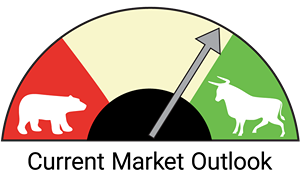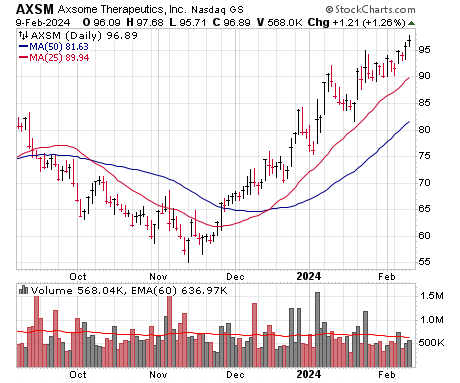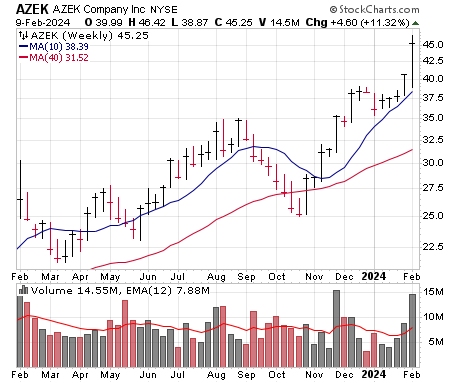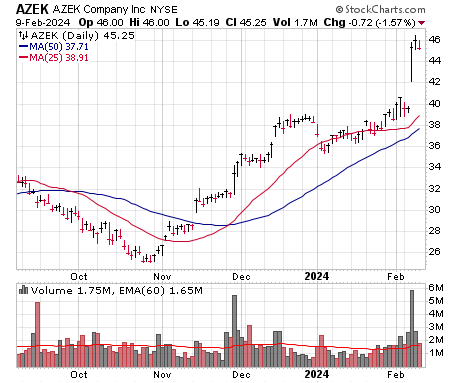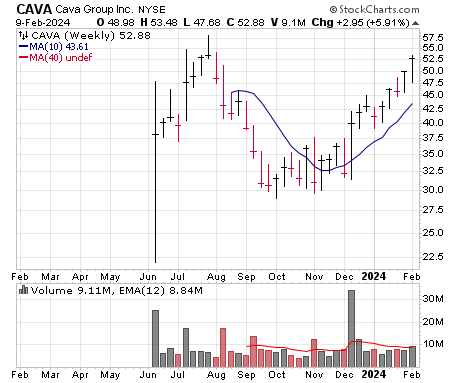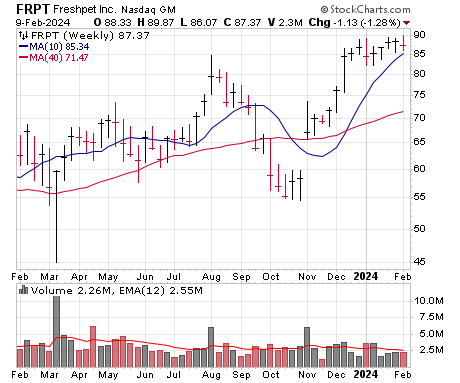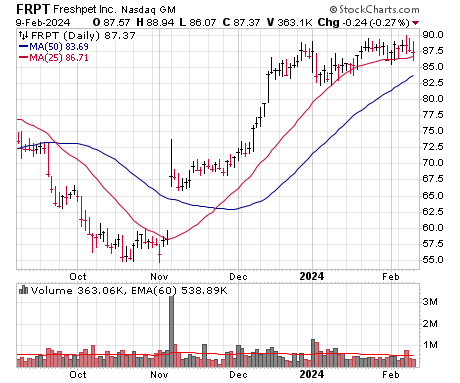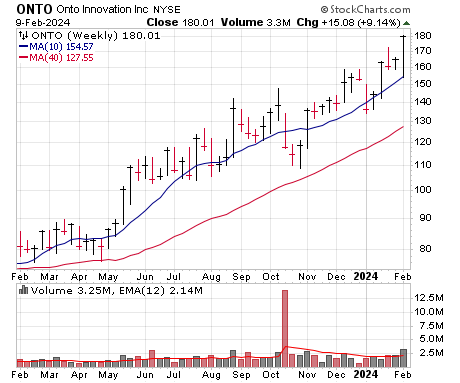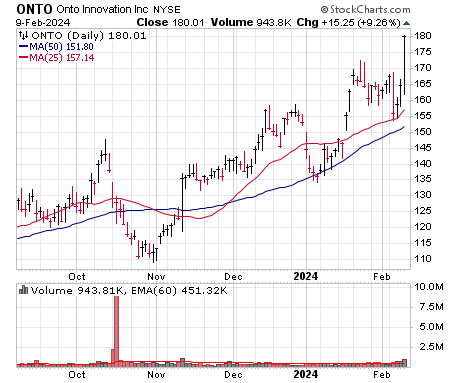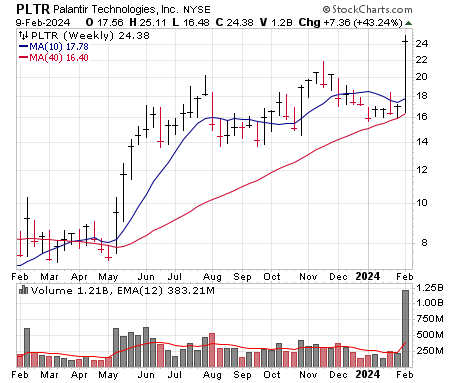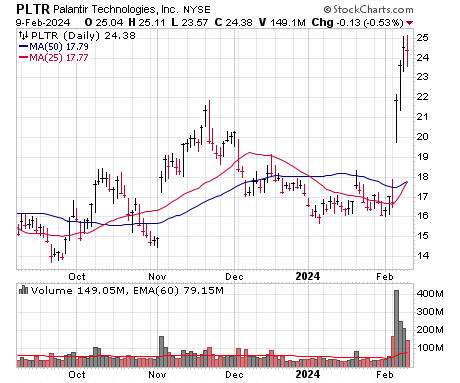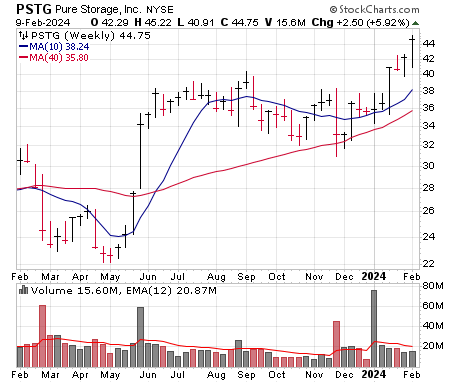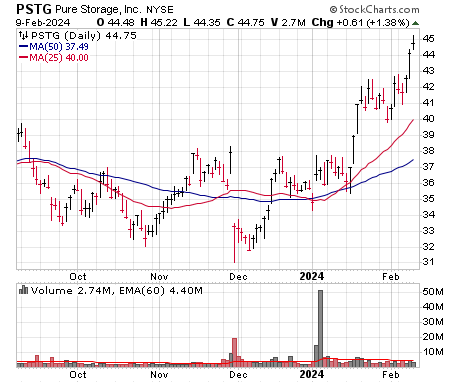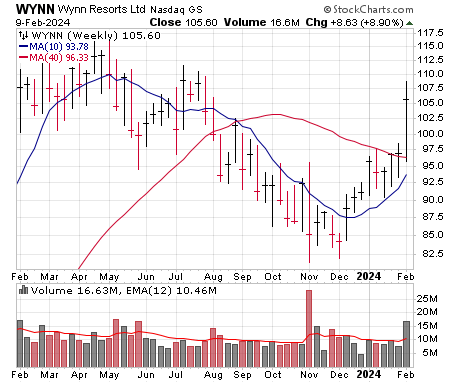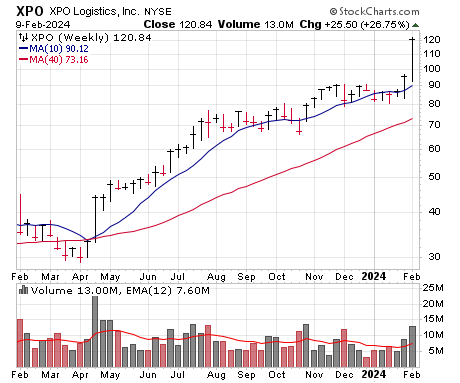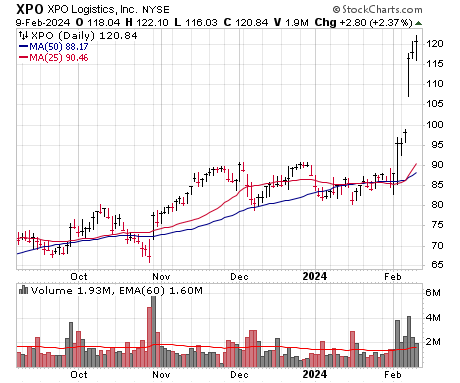Same Story: Strong, but Extended With Some Froth
Housekeeping: Just a heads up that next week’s issue will come after the close on Tuesday, February 20 due to the Presidents’ Day holiday.
The story remains the same as it has for a couple of weeks now: The trends of the indexes remain up and the action of leading stocks (especially leading growth stocks) remains excellent, with many tech names soaring but many other areas doing well, too. That said, most of the market has just sat around since the start of the year (though we are seeing some broadening out of buying pressures the past couple of days) and, for some of the tech/AI names, the action is definitely short-term frothy, all of which raises the risk that we’ll see some convulsions or rotation. Because the evidence hasn’t changed, we’re not changing our stance: We’re leaving our Market Monitor at a level 7, holding our winners but also a little cash, while focusing on fresher names (both inside and outside of tech) that are emerging with some power.
This week’s list has a bunch of fresh ideas in a variety of areas—dips in many of them would be tempting. For our Top Pick we’re going to go with a zinger: Palantir (PLTR) is a name we’ve been watching for months, and last week’s earnings reaction was super-powerful. We’re OK nibbling here, but the name is extremely volatile, so use a loose stop if you enter.
Price |
| Axsome Therapeutics (AXSM) |
| AZEK (AZEK) |
| Cava Group (CAVA) |
| Freshpet (FRPT) |
| Monolithic Power Systems (MPWR) |
| Onto Innovation (ONTO) |
| Palantir (PLTR) ★ Top Pick ★ |
| Pure Storage (PSTG) |
| Wynn Resorts (WYNN) |
| XPO (XPO) |
Stock 1
Axsome Therapeutics (AXSM)
Price |
Why the Strength
Axsome announced it’s testing its flagship drug, solriamfetol (marketed as Sunosi), to treat major depressive disorder, which would be a new indication for the drug and the first treatment for MDD that focuses on the body’s trace-amine TAAR1 receptor, which has only become recognized in recent years as having a potentially significant impact on neurological and psychiatric disorders. Axsome has already been successfully expanding the usage of Sunosi since it acquired the drug from Jazz Pharmaceuticals for $53 million two years ago, making it increasingly likely the treatment will turn out to be the blockbuster the company expects. Sunosi is currently approved to treat excessive daytime sleepiness in people with narcolepsy or obstructive sleep apnea, affecting 200,000 Americans. The company is advancing expansion of Sunosi to treat ADHD, a gigantic pharmaceutical market in the U.S.; top-line results from the ADHD trials are expected later this year. In late 2022, Axsome brought its first in-house developed drug to market, Auvelity, which treats MDD in adults. Altogether, the drugs generated nearly $58 million in revenue (up more than three-fold from the prior year, albeit off a low base) in the third quarter, ended September, three-quarters of which came from Auvelity. Management declined to guide Q4 results, which come next Tuesday (February 20; remember Monday is a holiday) before the open, though the consensus is for $69 million revenue and a net loss per share of $1.17. Given Auvelity will have been on the market for more than a year, analysts will be looking for news the drug is performing as effectively as expected, something Axsome expects. Investors will also want to see a treatment for fibromyalgia, AXS-14, is on track for submission the first half of this year. For 2024, early consensus is for sales of $391 million, up 46%, though obviously, clinical trial updates will be key.
Technical Analysis
AXSM rallied up to 80 in late 2022, and interestingly, that level held as tough resistance for the next nine months, with the stock eventually giving way to the sellers, dipping to the mid-50s in mid-November. But since then, AXSM has been a different animal—it’s rallied 12 of the past 13 weeks, ignoring even some wobbles seen in the biotech sector, as shares moved to new high ground in recent days. With round-number resistance at the century mark dead ahead, we suggest aiming for dips toward the rising 25-day line.
| Market Cap | $4.58B | EPS $ Annual (Dec) | ||
| Forward P/E | N/A | FY 2021 | -3.47 | |
| Current P/E | N/A | FY 2022 | -4.73 | |
| Annual Revenue | $224M | FY 2023e | -4.22 | |
| Profit Margin | N/A | FY 2024e | -2.74 | |
| Qtrly Rev | Qtrly Rev Growth | Qtrly EPS | Qtrly EPS Growth | |
| ($M) | (vs. yr-ago-qtr) | ($) | (vs. yr-ago-qtr) | |
| Latest qtr | 57.8 | 243% | -1.32 | N/A |
| One qtr ago | 46.7 | 429% | -1.54 | N/A |
| Two qtrs ago | 94.6 | N/M | -0.26 | N/A |
| Three qtrs ago | 24.4 | N/M | -1.51 | N/A |
Weekly Chart | Daily Chart |
Stock 2
AZEK (AZEK)
Price |
Why the Strength
More and more homeowners prefer eco-friendly, easy-to-maintain outdoor siding and decking options for their houses—especially as traditional wood products become more expensive, hence boosting the total cost of ownership advantages for the firm’s offerings. Chicago-based AZEK is recognized as one of the market leaders in outdoor living products (decking, siding, molding and lighting), most of which are made from approximately 90% recycled material and designed to replace the use of wood on the outside of homes; the company plays in both the residential market (capped polymer and composite decking, railing, porch, lighting and paver products) and commercial segment (high-quality bathroom lockers and partitions). AZEK’s premium portfolio of outdoor products is high-margin and is benefiting from declining raw material costs and improving manufacturing productivity, attributes that were highlighted during last week’s earnings call when management pointed to “strong gross margin performance and more normalized production levels.” Revenue in fiscal Q1 (ended December 31) increased 11% from a year ago to $240 million, driven by a 24% boost in residential sales, while earnings of 10 cents a share topped estimates by nine cents (the reason for the stock’s strength). Adjusted EBITDA grew “substantially” while EBITDA margins expanded 16 percentage points to 23%, and the firm’s contractors reported project backlogs of seven weeks—above pre-pandemic levels and suggesting Q1 sales weren’t due to backlog drawdowns. Going forward, AZEK plans to increase its use of recycled materials and improve product designs, which it sees leading to further margin expansion, while optimism remains that lower mortgage rates (despite the recent upmove) will goose the housing market. Wall Street hiked estimates nicely after the report and sees fiscal 2024’s bottom line lifting more than 50%, with further growth beyond that.
Technical Analysis
AZEK got back to 35 last August before being hit with a wave of selling, falling eight straight weeks as the market sank into its final low. The rebound from there was terrific, though, with shares pushing to new highs in just seven weeks—and, nearly as impressive, AZEK then formed a very tight, quiet, five-week zone between 35 and 39, suggesting big investors were holding on tightly to their positions. New highs came two weeks ago, with last week’s reaction leaving no doubt the buyers are in control. Aim for dips if you want in.
| Market Cap | $6.60B | EPS $ Annual (Sep) | ||
| Forward P/E | 39 | FY 2022 | 0.97 | |
| Current P/E | 49 | FY 2023 | 0.74 | |
| Annual Revenue | $1.40B | FY 2024e | 1.16 | |
| Profit Margin | 8.5% | FY 2025e | 1.32 | |
| Qtrly Rev | Qtrly Rev Growth | Qtrly EPS | Qtrly EPS Growth | |
| ($M) | (vs. yr-ago-qtr) | ($) | (vs. yr-ago-qtr) | |
| Latest qtr | 240 | 11% | 0.10 | N/A |
| One qtr ago | 389 | 28% | 0.36 | 125% |
| Two qtrs ago | 388 | -2% | 0.30 | 3% |
| Three qtrs ago | 378 | -5% | 0.18 | -45% |
Weekly Chart | Daily Chart |
Stock 3
Cava Group (CAVA)
Price |
Why the Strength
Cava is a restaurant and catering brand that focuses on Mediterranean food – think Greek and Lebanese fare like gyros and falafel. The business follows in the steps of other fast-casual outlets like Chipotle and Sweetgreen in that its counter service format offers healthier options—heavy on salads and flavored seltzer drinks. Cava generates most (55%) of its business from the daytime lunch crowd (dinner is 45%), and like everyone else these days, it’s made a big move into digital ordering (36% of sales, plays well with the office crowd for lunch) as well as offering catering of the same items it offers in store. Cava sees itself as a category-defining concept given its menu focus, while investors like that the business is growing fast and should have tons of white space to expand for many years to come. Cava has about 290 locations in two dozen states, opening about 70 stores—new locations and conversions of purchased Middle Eastern restaurants (Zoes Kitchen)—in 2023. The numbers are a bit weird because of the transition of many locations from Zoes to Cava, but the bottom line is that business is good and the upside is big: In Q3, total sales rose 26% while Cava-only revenue boomed nearly 50% as same-store sales lifted 14%, gains that outpaced the rise in customer traffic. What’s also appealing to investors is that Cava has no debt and already makes consistent profits ($0.06 per share and EBITDA was nearly $20 million in Q3). Management is focusing on an academy program to train general managers to take over new locations, revising its loyalty program for 2024 and making sure it’s diversified in lease terms and landlords to mitigate real estate risks. Big picture, the restaurant count should expand rapidly for many years, and if costs can be contained (always tricky with newer restaurants), there’s no reason the bottom line can’t lift nicely for a long time to come. Q4 results are due February 27.
Technical Analysis
CAVA held its IPO in June at 22 and eventually galloped as high as 58 before the typical post-IPO droop took hold, pulling the stock down to 30 or so in October. The stock tested that level for the next few weeks before a giant-volume rally in December (the post-IPO lockup came and went without an issue), and CAVA has been trending higher since then, with the move accelerating higher in recent days. We like the action but advise looking for a pre-earnings shakeout to start a position.
| Market Cap | $6.00B | EPS $ Annual (Dec) | ||
| Forward P/E | 331 | FY 2021 | -0.33 | |
| Current P/E | 660 | FY 2022 | -0.52 | |
| Annual Revenue | $682M | FY 2023e | 0.17 | |
| Profit Margin | 3.9% | FY 2024e | 0.16 | |
| Qtrly Rev | Qtrly Rev Growth | Qtrly EPS | Qtrly EPS Growth | |
| ($M) | (vs. yr-ago-qtr) | ($) | (vs. yr-ago-qtr) | |
| Latest qtr | 176 | 26% | 0.06 | N/A |
| One qtr ago | 173 | 27% | 0.21 | N/A |
| Two qtrs ago | 203 | 28% | -0.02 | N/A |
| Three qtrs ago | 130 | 11% | -0.17 | N/A |
Weekly Chart | Daily Chart |
Stock 4
Freshpet (FRPT)
Price |
Why the Strength
We’re continuing to keep an eye out for smaller growth stocks outside of the hot AI/chip/networking area that could kick into gear should the buying pressures broaden (which we’re just starting to see). Freshpet is one of them, with a great, long-lasting growth story in an easy-to-understand, consumer-facing sector. For years, the firm has been the leading player in “fresh” pet food (almost all of it for dogs), which plays into the “pet is part of the family” trend that’s been advancing for years; the food has also been shown to lead to healthier and longer lives for Fido and Whiskers. Freshpet hit some major potholes a couple of years ago, with costs getting out of whack, but the period of heaviest investment is soon to be in the past, aggressive price hikes were mostly swallowed whole by customers, all while advertising brings in more customers, distribution expands and new manufacturing facilities get busier. That means the superb demand trends seen here (21 straight quarters of at least 25% revenue growth!!) are hitting the bottom line. Indeed, in Q3 (reported in early November), net loss shrunk while EBITDA came in at $23 million (up from $4 million a year ago), all better than expected, and while the current numbers are important, the real payoff is with the big picture: The top brass thinks its household penetration can expand a total of 77% by 2027 (to 20 million households), driving revenues up 138% between 2023 and 2027 as EBITDA booms five-fold thanks to growing awareness (“only” 58% of people are familiar with Freshpet; the national ad campaign is helping here), increased usage (60% of customers use it as a “topper” and not the main meal) and better efficiencies and margins (new production facility beginning to ramp in Q3 of this year). It’s not changing the world, but all signs point to rapid and reliable growth for a long time to come. Earnings are due February 26.
Technical Analysis
FRPT has a nice setup here that lends itself to a good risk/reward trade … if the stock can get going. Shares effectively had a jagged year-long bottoming process from late 2022 through last October, and then a post-earnings run starting in November brought the stock to marginal new highs. And since then, FRPT has been very quiet, with a little volatility in early January followed by some very tight action. We’ll set our buy range up from here, looking for a strong breakout to enter.
| Market Cap | $4.21B | EPS $ Annual (Dec) | ||
| Forward P/E | N/A | FY 2021 | -0.69 | |
| Current P/E | N/A | FY 2022 | -1.29 | |
| Annual Revenue | $718M | FY 2023e | -0.85 | |
| Profit Margin | N/A | FY 2024e | -0.18 | |
| Qtrly Rev | Qtrly Rev Growth | Qtrly EPS | Qtrly EPS Growth | |
| ($M) | (vs. yr-ago-qtr) | ($) | (vs. yr-ago-qtr) | |
| Latest qtr | 201 | 33% | -0.15 | N/A |
| One qtr ago | 183 | 26% | -0.35 | N/A |
| Two qtrs ago | 168 | 27% | -0.52 | N/A |
| Three qtrs ago | 166 | 43% | -0.06 | N/A |
Weekly Chart | Daily Chart |
Stock 5
Monolithic Power Systems (MPWR)
Price |
Why the Strength
Megatrends in artificial intelligence, autonomous vehicles and industrial automation are just some of the catalysts driving demand for Monolithic Power’s storage and computer chip portfolio. The company provides integrated power semiconductor solutions used for cloud computing, telecom, automotive and industrial applications, delivering billions of parts annually to some of the world’s largest tech firms. By integrating all necessary components into a single packet, the company’s ultra-compact, space-saving modules boast exceptional power density and high efficiency, as well as some of the lowest failure rates in the chip industry. Monolithic Power last week announced record revenue of $1.8 billion for 2023—its 12th consecutive year of top-line growth—as well as the acquisition of a Netherlands-based company specializing in programmable multi-core digital signal processors for the consumer and automotive audio market, allowing Monolithic to expand into a new $1 billion market (both reasons for the stock’s strength). Although Q4 total revenue was 1% lower from a year ago, full-year sales increased 2%, led by a 30% revenue jump in the firm’s enterprise data segment (18% of revenue) thanks to higher sales of its power management solutions for AI applications. Full-year automotive segment sales (22% of revenue) grew 32%, driven by higher demand for applications supporting advanced driver assistance systems, digital cockpits and lighting applications. Also contributing was a 9% growth spurt in storage and computing (27% of revenue), thanks to higher notebook sales. At its core, this is a very profitable business (pre-tax margins of 35%!) and analysts see the top line galloping ahead starting in Q2 and continuing for the next several quarters after that as the new chip upcycle gains traction. Earnings estimates are likely to prove low.
Technical Analysis
After troughing above 400 last October, MPWR shot up on earnings later that month and motored to marginal new highs before meeting with strong resistance at 650 in December. As opposed to the prior couple of years where rallies were crushed, MPWR instead went on to build a reasonable seven-week zone that respected the 50-day line—and then came last Thursday’s earnings gap to new highs. The action is obviously solid, though we’ll set our buy range down a smidge, expecting a little exhale near term.
| Market Cap | $36.0B | EPS $ Annual (Dec) | ||
| Forward P/E | 59 | FY 2022 | 12.41 | |
| Current P/E | 63 | FY 2023 | 11.78 | |
| Annual Revenue | $1.82B | FY 2024e | 12.82 | |
| Profit Margin | 35.5% | FY 2025e | 16.22 | |
| Qtrly Rev | Qtrly Rev Growth | Qtrly EPS | Qtrly EPS Growth | |
| ($M) | (vs. yr-ago-qtr) | ($) | (vs. yr-ago-qtr) | |
| Latest qtr | 454 | -1% | 2.88 | -9% |
| One qtr ago | 475 | -4% | 3.08 | -13% |
| Two qtrs ago | 441 | -4% | 2.82 | -13% |
| Three qtrs ago | 451 | 19% | 3.00 | 22% |
Weekly Chart | Daily Chart |
Stock 6
Onto Innovation (ONTO)
Price |
Why the Strength
AI-focused semiconductor use is expected to skyrocket in the coming years, and that means rising demand for advanced chip packaging and inspection, functions that serve to connect the chip to other components and systems. Onto provides process and control equipment and software, as well as a breadth of offerings spanning the entire semiconductor value chain, from 3D metrology, macro defect inspection and factory analytics, to lithography for advanced semiconductor packaging. The key offering for investors right now is its Dragonfly G3 inspection system, which is of vital importance for supporting memory and logic devices for AI applications. In Q4 (results released last week), the company posted $219 million in Dragonfly sales, exceeding the high end of the firm’s guidance and increasing 6% from the prior quarter. While total revenue was 13% lower from a year ago, it still beat Wall Street’s estimates, with per-share earnings of $1.06 doing the same (by 5%), as well as contributing to the latest share price strength. In the earnings call, Onto emphasized that the world’s top chipmakers are increasing their investments in advanced packaging, including chiplet and 3D memory architectures. Consequently, the firm expects demand for the Dragonfly G3 system to correspondingly increase in the coming years as AI chip architectures become more complex. Additionally, Onto is benefiting from the expanding use of lithography tools used by leading-edge panel manufacturers, recently launching its latest Firefly G3 panel inspection system, while also scoring two big customer wins for it in the mobile and high-performance compute space. Moving forward, management expects AI packaging to be a “strong driver” for 2024, with backlog already extending into the second half of the year—analysts see a big turnaround starting in the current quarter, with the bottom line lifting 25%-plus each of the next two years. Onto is a down-the-food-chain story that should benefit from the AI boom.
Technical Analysis
ONTO broke out from a big base in May of last year and has been trending higher ever since, albeit with plenty of dips and rest periods along the way, the toughest of which came in October (26% drop in less than a month). Even so, the buyers have returned after every retreat, with the 50-day line generally offering support when things turn weak. Last week’s earnings-induced move was solid, coming on three straight days of big volume, though we’re thinking a pullback is likely near term, and should provide a solid entry point.
| Market Cap | $8.83B | EPS $ Annual (Dec) | ||
| Forward P/E | 39 | FY 2022 | 5.52 | |
| Current P/E | 44 | FY 2023 | 3.73 | |
| Annual Revenue | $816M | FY 2024e | 4.67 | |
| Profit Margin | 28.3% | FY 2025e | 5.91 | |
| Qtrly Rev | Qtrly Rev Growth | Qtrly EPS | Qtrly EPS Growth | |
| ($M) | (vs. yr-ago-qtr) | ($) | (vs. yr-ago-qtr) | |
| Latest qtr | 219 | -14% | 1.06 | -32% |
| One qtr ago | 207 | -19% | 0.96 | -29% |
| Two qtrs ago | 191 | -26% | 0.79 | -38% |
| Three qtrs ago | 199 | -17% | 0.92 | -30% |
Weekly Chart | Daily Chart |
Stock 7
Palantir (PLTR) ★ Top Pick ★
Price |
Why the Strength
Palantir has seemed perfectly positioned for the AI boom for about a year now: The company’s history as a provider of advanced software and analytical/security platforms for government entities (especially U.S. and friendly militaries) means it’s been leveraging various forms of AI and machine learning for years, putting it way ahead of others when it comes to developing a platform that can be mass adopted not just by governments, but by big companies looking to dramatically streamline operations—and do it in a secure, measured way as well, with systems able to take proprietary or public language models and mine through pretty much any type of “data” even including messaging conversations, video, audio and more. The trick was how long it would take for interest in Palantir’s offerings to result in real sales; Palantir quickly went to work holding individual “boot camps” with firms that showcase how its platform can be used with that potential client, with 565 of these meetings in just the past six months or so. And that has been a big factor in the acceleration of demand among the private sector: In Q4, U.S. commercial revenue surged 70% as the customer count lifted 55% and total contract value inked more than doubled (and rose 42% from the prior quarter!), with new clients (including some huge ones) signing up and existing clients expanding their usage. Of course, from a total-company standpoint, U.S. commercial revenues are still just 22% of revenues, but (a) that’s likely to grow in a big way going ahead, and (b) the top brass had positive things to say about its government business (53% of revenue), which did grow 11% in Q4 and should pick up steam as 2024 moves along and more AI adoption occurs there. Of course, expectations are high, but whereas most of the focus now is on AI infrastructure (chips, networking gear, etc.), Palantir looks like the clear early leader in providing a platform that can offer direct, meaningful savings to big companies (and, eventually, governments) around the globe. It’s a huge idea.
Technical Analysis
PLTR went wild during the initial AI move last spring, soaring on six straight weeks of big-volume buying and eventually making its way up to round-number resistance near 20 in July—but that ushered in a very choppy, tedious few months, with the stock dipping as much as 30% and sitting at 16 (and tagging its 40-week line) two weeks ago. But the Q4 report changed all that, with a huge earnings move coming on out-of-this-world volume. Volatility is sure to continue, so use a loose leash, but the path of least resistance is now up.
| Market Cap | $53.1B | EPS $ Annual (Dec) | ||
| Forward P/E | 67 | FY 2022 | 0.06 | |
| Current P/E | 98 | FY 2023 | 0.25 | |
| Annual Revenue | $2.22B | FY 2024e | 0.34 | |
| Profit Margin | 41.1% | FY 2025e | 0.39 | |
| Qtrly Rev | Qtrly Rev Growth | Qtrly EPS | Qtrly EPS Growth | |
| ($M) | (vs. yr-ago-qtr) | ($) | (vs. yr-ago-qtr) | |
| Latest qtr | 608 | 20% | 0.08 | 100% |
| One qtr ago | 558 | 17% | 0.07 | 600% |
| Two qtrs ago | 533 | 13% | 0.05 | N/A |
| Three qtrs ago | 525 | 18% | 0.05 | 150% |
Weekly Chart | Daily Chart |
Stock 8
Pure Storage (PSTG)
Price |
Why the Strength
The leaders of the AI movement are clearly in the chip and networking field, but as the advance broadens out, it’s a good bet the need for vastly greater storage will come into focus—and Pure Storage should be a winner there. While the field is obviously crowded with many players, Pure is known as the new-age leader, with flash-based offerings that use less power (80% less power for all-flash systems), take up less space, are more reliable and, overall, have a total cost of ownership that’s about half of standard offerings, according to the company. There’s also the business model angle—while half of revenues are still traditional sales, the other half is via subscription, with Pure’s Evergreen product line-up allowing clients to avoid the repeated upgrade cycles of the past and always have the latest and greatest features in exchange for a regular fee. Overall, the firm’s combined offerings have been a hit, with more than 12,000 customers, including 60% of the Fortune 500, and while the headline growth numbers faded a bit as subscriptions picked up (payments made over time instead of all at once), the sub-metrics have been strong: In the quarter ending in October, Pure’s annualized recurring revenue totaled $1.30 billion, up 26% from a year ago (and up 6.6% sequentially) while remaining performance obligations (all the money under contract that’s due to Pure) rose to $2.05 billion, up 30% from a year ago (and 8.5% sequentially), with free cash flow picking up steam. And now, of course, there’s the AI potential, with some of its customers (like Meta) talking about boosting investment in that field. The upcoming earnings report (February 28) will be vital to see how demand trends are shaping up, but Pure has a solid business that could accelerate if all goes well. Interestingly, the firm has about $1 billion of net cash (cash less debt) on the books, which is a plus should the top brass see an opportunity.
Technical Analysis
PSTG went from 52-week lows to 52-week highs in just a few weeks last spring when the initial AI surge occurred, but then shares went dead as earnings results were just OK and investors looked elsewhere—even after the market got going in November, the stock was mostly waterlogged. But things began to change in mid-January, with a modest-volume move to new highs, and last week, the stock extended further to the upside and it’s shown little desire to pull in. We like the action, but given the lack of buying volume so far, we advise aiming for dips if you want in.
| Market Cap | $14.1B | EPS $ Annual (Jan) | ||
| Forward P/E | 29 | FY 2022 | 0.78 | |
| Current P/E | 30 | FY 2023 | 1.32 | |
| Annual Revenue | $2.85B | FY 2024e | 1.36 | |
| Profit Margin | 22.9% | FY 2025e | 1.52 | |
| Qtrly Rev | Qtrly Rev Growth | Qtrly EPS | Qtrly EPS Growth | |
| ($M) | (vs. yr-ago-qtr) | ($) | (vs. yr-ago-qtr) | |
| Latest qtr | 763 | 13% | 0.50 | 61% |
| One qtr ago | 689 | 6% | 0.34 | 6% |
| Two qtrs ago | 589 | -5% | 0.08 | -68% |
| Three qtrs ago | 810 | 14% | 0.53 | 47% |
Weekly Chart | Daily Chart |
Stock 9
Wynn Resorts (WYNN)
Price |
Why the Strength
After almost three years of near-zero arrivals due to Covid restrictions, gambling tourism in Macau is back in a big way, with 28 million visitors visiting China’s premier gaming destination last year—more than 70% above pre-pandemic 2019 levels. The return of Macau is a big reason for the strength behind Wynn Resorts, which is well known for its destination casino resorts, with locations in Las Vegas, Boston Harbor, Macau and Cotai (as well as for its online gaming division, Wynn Interactive). With the recent Chinese New Year, Macau expects record arrivals of up to 200,000 revelers, which should help boost revenue for Wynn. What’s more, this past Sunday’s Super Bowl, which was hosted in Las Vegas for the first time, was likely another big score for the company. Accounting for the latest share price pop, however, was last week’s Q4 report and what it portends in general: It featured some sizzling top- and bottom-line beats, with revenue of $1.8 billion up 83% from a year ago, while earnings of $1.91 per share topped estimates by 65%. The company noted that “strong momentum” continued throughout 2023 and into Q4, with adjusted property EBITDA (a key metric) reaching a new all-time record of $630 million and more than quadrupling year-on-year, thanks to a 20% revenue increase in the Las Vegas operations and a whopping 400% jump from Macau. Wynn said its Macau business continues to expand while running “structurally higher” margins than in the past, but it also has high hopes for a $4 billion tourism destination currently under development in the UAE (to open in 2027, and for which it sees a “substantial” growth opportunity). It’s not a true growth company anymore, but Wynn is a top-notch operator in the midst of a solid turnaround that should produce solid cash flow and earnings growth going ahead—and the stock is finally discounting that.
Technical Analysis
The Macau gaming slump shaved more than 60% off WYNN’s share price between 2021 and 2022, and after a sharp rebound into last March, shares sagged again, this time for nine months into early December. However, that was the low, with WYNN nosing higher for a few weeks—and last week’s earnings reaction popped the stock above its 40-week line for the first time since last August. We think the path of least resistance has turned up, though don’t be shocked to see some near-term wiggles.
| Market Cap | $11.9B | EPS $ Annual (Dec) | ||
| Forward P/E | 21 | FY 2022 | -4.47 | |
| Current P/E | 26 | FY 2023 | 4.10 | |
| Annual Revenue | $6.53B | FY 2024e | 4.93 | |
| Profit Margin | 11.9% | FY 2025e | 5.59 | |
| Qtrly Rev | Qtrly Rev Growth | Qtrly EPS | Qtrly EPS Growth | |
| ($B) | (vs. yr-ago-qtr) | ($) | (vs. yr-ago-qtr) | |
| Latest qtr | 1.84 | 83% | 1.91 | N/A |
| One qtr ago | 1.67 | 88% | 0.99 | N/A |
| Two qtrs ago | 1.60 | 76% | 0.91 | N/A |
| Three qtrs ago | 1.42 | 49% | 0.29 | N/A |
Weekly Chart | Daily Chart |
Stock 10
XPO (XPO)
Price |
Why the Strength
After a two-year slump, the freight shipping industry is turning a corner as retailers restock inventory following a long period of tightening, contributing to an increase in freight rates. XPO is one of North America’s largest less-than-truckload (LTL) transportation providers, with coverage spanning the U.S., Canada, Mexico and the Caribbean, and with a fleet of more than 38,000 semi-trailer trucks across 562 locations. The company has worked to become leaner in recent years after spinning off its contract logistics and truck brokerage businesses, and that strategy appears to be paying off: Its damage claims ratio (a key metric) improved to a new company record in Q4, while customer satisfaction increased by more than 40%. The increased efficiency was also observable in another important measure, namely XPO’s operating ratio (the cost of generating each dollar of revenue), which improved 2% in Q4 from a year ago to 87%. Revenue of nearly $2 billion rose 6%, driven by higher rates (excluding fuel) and an increase in tonnage per day in the North American LTL segment, while per-share earnings of 77 cents beat the consensus by 15 cents. Other metrics were equally sanguine, including on-time performance, which improved by three percentage points from last year’s Q4. Aside from its focus on improving efficiency, XPO is also committed to growing its fleet, which it did to the tune of 1,400 new tractors and trailers in 2023—more than any year in its history—and which XPO said will further its strategy to in-source more line-haul miles going forward. The top brass said the company is seeing “strong pricing trends” in early 2024 and expects a solid overall year across all key metrics, with the bankruptcy of Yellow (and a still-strong economy) likely helping the cause. Wall Street sees results accelerating starting early this year.
Technical Analysis
XPO shot out of the gate last April on monster volume and went on a huge run to the 75 area, where it built two brief bases—the first (August through October) resulted in a post-Q3 earnings move to new highs, but that was followed by an eight-week zone in the 80 to 90 area through January. Now we see XPO (and some peers, like SAIA) letting loose on the upside following Q4 results—a potential group move. We’ll set our buy range down a bit after the recent moonshot, though we’re not expecting a huge retreat.
| Market Cap | $14.0B | EPS $ Annual (Dec) | ||
| Forward P/E | 35 | FY 2022 | 3.52 | |
| Current P/E | 40 | FY 2023 | 2.92 | |
| Annual Revenue | $7.75B | FY 2024e | 3.45 | |
| Profit Margin | 6.2% | FY 2025e | 4.81 | |
| Qtrly Rev | Qtrly Rev Growth | Qtrly EPS | Qtrly EPS Growth | |
| ($B) | (vs. yr-ago-qtr) | ($) | (vs. yr-ago-qtr) | |
| Latest qtr | 1.94 | 6% | 0.77 | -21% |
| One qtr ago | 1.98 | 2% | 0.88 | -7% |
| Two qtrs ago | 1.92 | -6% | 0.71 | -38% |
| Three qtrs ago | 1.91 | 1% | 0.56 | 22% |
Weekly Chart | Daily Chart |
Previously Recommended Stocks
| Date | Stock | Symbol | Top Pick | Original Buy Range | 2/12/24 |
| HOLD | |||||
| 1/22/24 | 64-66 | 71 | |||
| 12/18/23 | 133-137 | 172 | |||
| 1/29/24 | 196-201 | 212 | |||
| 2/5/24 | 217-225 | 234 | |||
| 1/8/24 | 128-133 | 144 | |||
| 1/29/24 | 860-885 | 930 | |||
| 2/5/24 | 252-259 | 267 | |||
| 1/22/24 | 191-196 | 198 | |||
| 9/5/23 | ★ | 161-166 | 322 | ||
| 12/18/23 | 120-124 | 135 | |||
| 12/11/23 | ★ | 45.5-48 | 61 | ||
| 1/29/24 | 81-82.5 | 86 | |||
| 11/6/23 | ★ | 33-35 | 44 | ||
| 12/4/23 | 106-112 | 128 | |||
| 2/5/24 | 224-230 | 246 | |||
| 1/2/24 | 82.5-85.5 | 89 | |||
| 1/16/24 | 102-105 | 112 | |||
| 2/5/24 | 93.5-96 | 98 | |||
| 1/2/24 | 67.5-69.5 | 73 | |||
| 1/8/24 | 146-150 | 158 | |||
| 11/6/23 | 433-445 | 533 | |||
| 1/22/24 | 63.5-65.5 | 71 | |||
| 1/29/24 | 545-565 | 558 | |||
| 2/5/24 | 53-55 | 59 | |||
| 1/8/24 | 104-107 | 120 | |||
| 9/5/23 | ★ | 33-34.5 | 57 | ||
| 2/27/23 | 225-230 | 723 | |||
| 11/20/23 | ★ | 86.5-89 | 106 | ||
| 2/5/24 | ★ | 510-525 | 561 | ||
| 1/29/24 | 66.5-68.5 | 68 | |||
| 1/16/24 | 77-80 | 89 | |||
| 2/5/24 | 208-216 | 233 | |||
| 10/30/23 | 166-169 | 234 | |||
| 1/22/24 | ★ | 110-114 | 131 | ||
| 11/6/23 | 77-79 | 105 | |||
| 1/16/24 | 77-80 | 88 | |||
| 5/8/23 | 37-39 | 69 | |||
| 12/4/23 | 505-515 | 663 | |||
| 12/4/23 | ★ | 44-46 | 61 | ||
| 1/29/24 | ★ | 58-60 | 57 | ||
| 2/5/24 | WillScotMobile | WSC | 47.5-49.5 | 52 | |
| WAIT | |||||
| 2/5/24 | 33.5-35.5 | 38 | |||
| 2/5/24 | Zillow | Z | 59-60.5 | 56 | |
| SELL | |||||
| 1/16/24 | 47-48.5 | 44 | |||
| 1/22/24 | 22.5-23.5 | 32 | |||
| 12/11/23 | 58-60.5 | 73 | |||
| 1/16/24 | ★ | 86-89 | 96 | ||
| 1/8/24 | 80-83 | 98 | |||
| 1/2/24 | ★ | 127-132 | 130 | ||
| 11/6/23 | 29.5-31 | 36 | |||
| 1/8/24 | ★ | 16.5-17.5 | 12 | ||
| 1/16/24 | 357-367 | 400 | |||
| 1/8/24 | 20.5-21.5 | 22 | |||
| 1/29/24 | Worthington Entrprs | WOR | 55-57 | 63 | |
| DROPPED | |||||
| 1/29/24 | 210-220 | 247 | |||
| 1/29/24 | 23-25 | 30 | |||
| 1/29/24 | 450-475 | 774 | |||
The next Cabot Top Ten Trader issue will be published on February 20, 2024.
Copyright © 2024. All rights reserved. Copying or electronic transmission of this information without permission is a violation of copyright law. For the protection of our subscribers, copyright violations will result in immediate termination of all subscriptions without refund. Disclosures: Cabot Wealth Network exists to serve you, our readers. We derive 100% of our revenue, or close to it, from selling subscriptions to our publications. Neither Cabot Wealth Network nor our employees are compensated in any way by the companies whose stocks we recommend or providers of associated financial services. Employees of Cabot Wealth Network may own some of the stocks recommended by our advisory services. Disclaimer: Sources of information are believed to be reliable but they are not guaranteed to be complete or error-free. Recommendations, opinions or suggestions are given with the understanding that subscribers acting on information assume all risks involved. Buy/Sell Recommendations: are made in regular issues, updates, or alerts by email and on the private subscriber website. Subscribers agree to adhere to all terms and conditions which can be found on CabotWealth.com and are subject to change. Violations will result in termination of all subscriptions without refund in addition to any civil and criminal penalties available under the law.

